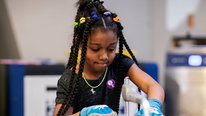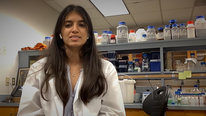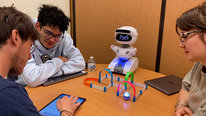- Lara Hebert
- Asst. Director of Outreach & Public Engagement
- Presenter’s NSFRESOURCECENTERS
- University of Illinois Urbana-Champaign
- Beth Kirchgesner
- Assistant Coordinator
- Presenter’s NSFRESOURCECENTERS
- University of Illinois Urbana-Champaign
- Meagan Pollock
- https://www.linkedin.com/in/meaganpollock/
- NAPE Consultant + Founder, Engineer Inclusion
- Presenter’s NSFRESOURCECENTERS
- National Alliance for Partnerships in Equity, Engineer Inclusion
Strategies: Catalyzing Inclusive STEM Experience All Year Round (CISTEME365)
NSF Awards: 1850398
2022 (see original presentation & discussion)
Grades 6-8, Grades 9-12, Undergraduate, Adult learners
A frequent strategy aimed at broadening participation in STEM is to provide increased access to formal and informal STEM programs as children are growing up. This strategy aims to address issues of opportunity gaps that affect historically marginalized groups disproportionately, particularly those in economically distressed settings. Other efforts focus on the people and environment in an effort to increase cultural humility and reduce bias in the education system. This often occurs through DEI training and evidence-based action plans. Both strategies are important but are often implemented in isolation.
The Catalyzing Inclusive STEM Experiences All Year Round (CISTEME365) initiative takes a holistic approach to impact change in an effort to broaden participation in STEM. CISTEME365 offers increased out-of-school opportunities to engage in engineering projects and career exploration while also working with the school-based educators to create more equitable and inclusive STEM environments. Additionally, school counselors partner with the STEM educators on efforts to broaden participation in STEM in their school contexts. Over the past three years, we have flexed and stretched to continue this initiative despite a raging pandemic that required a shift from mostly in-person, to mostly remote, to somewhere in-between. Despite and perhaps as a result of these challenges, our well-grounded model for professional development that has been year-round, interactive and collaborative, became even more contextualized to meet the needs and interests of the individual schools.
While creating last year’s STEM4ALL submission, we realized that we could do even better with our efforts to merge the technical content with the social justice content. We expanded how we applied the Stanford d.school’s Design Thinking Model to stretch across various aspects of the CISTEME365 initiative, putting “empathy” first in the human-centered design process. This video spotlights how this professional development model and its use of action research by CISTEME365 participants focused on both the technical and the social, emotional, and contextual aspects of STEM teaching and learning.
Related Content for Empathy at the Heart of Design
-
 2022Pathways from Service to STEM for Women Veterans
2022Pathways from Service to STEM for Women Veterans
Rebecca Lewis
-
 2022Co-Design w/ Neurodiverse Learners: Team & VR Game Impacts
2022Co-Design w/ Neurodiverse Learners: Team & VR Game Impacts
Teon Edwards
-
 2022Using Narratives to Support Empathy and Engineering
2022Using Narratives to Support Empathy and Engineering
Dorothy Bennett
-
 2022Florida Transfer Student Pathways to Success in Microbiology
2022Florida Transfer Student Pathways to Success in Microbiology
Alexandria Ardissone
-
 2022MC2: Synthesizing Key Ideas about Collaborative Learning
2022MC2: Synthesizing Key Ideas about Collaborative Learning
Dalila Dragnic-Cindric
-
 2022Female STEM Recruitment Overview
2022Female STEM Recruitment Overview
Kevin Cooper
-
 2022Designing Innovative AI to Support K-12 Collaboration
2022Designing Innovative AI to Support K-12 Collaboration
Rachel Dickler
-
 2022SAIL-CC: Partnering to Improve Student Learning Outcomes
2022SAIL-CC: Partnering to Improve Student Learning Outcomes
Majd Sakr



Lara Hebert
Asst. Director of Outreach & Public Engagement
Welcome from the leadership team and participants of the Catalyzing Inclusive STEM Experiences All Year Round (CISTEME365) initiative. We are excited to engage with you in conversations about the engineering design process for social justice, and how this process not only applies to engineering design, but also to the design of our classroom and STEM Club environments. How are you using empathy to inform how you design your STEM education initiatives? What are the challenges? What are the benefits? We look forward to learning with and from you this week.
Meagan Pollock
Jasmine Maldonado
Very interesting, I have never seen empathy explicitly put into an EDP graphic. But I agree that it is an essential element. The NY Hall of Science has conducted some research and learned that even the framing of a design challenge prompt can make all the difference in engagement. Narratives that resonate with empathy and helping others increased engagement, particularly for girls in STEM. Happy to share articles and resources upon request!
Katherine Isbister
Fran Agnone
Lara Hebert
Asst. Director of Outreach & Public Engagement
Hi Jasmine. Thanks so much for sharing. Would definitely love to hear more about the empathy narratives around design challenge thoughts. Please do share! I think that this would really resonate with the IDEA Teams of teachers and counselors as they think about empathy and design in their STEM Club contexts. For more on empathy in design, we like the work and resources of Stanford's d.school
Jasmine Maldonado
Thanks for sharing! Here is an NSTA article about some of NYSCI's empathy research: https://www.nsta.org/connected-science-learning/connected-science-learning-july-september-2020/using-narratives-evoke
This same research team has submitted video at this conference as well that you can check out: "Using Narratives to Support Empathy & Engineering" presented by Dorothy Bennett & Susan Letourneau.
Christina Baze
Katherine Isbister
Meagan Pollock
NAPE Consultant + Founder, Engineer Inclusion
Thank you for sharing, Jasmine! I'll check out your video, too.
Christine Royce
Professor
I greatly appreciate the point that DEI initiatives are often over generalized and that opportunities to ensure DEI efforts in STEM specific contexts are needed. Additionally, the idea of creating teams of both teachers and counselors that work together and learn about STEM/DEI is a great idea so that a common and focused approach can be used.
Christina Baze
Paulina Romero
Lara Hebert
Asst. Director of Outreach & Public Engagement
Thanks, Christine. It's really been an interesting three years. Each of the IDEA Teams have functioned in their own unique ways to share the work of creating more equitable and inclusive STEM environments. The counselors and the STEM teachers gain more understanding of student experiences with technical projects and they learn from one another in ways they didn't anticipate.
Christine Royce
Professor
Can you describe more about how the different teams select their focus area and then incorporate the projects or experiences? Thanks also for providing the link to the article above about the program.
Susan Letourneau
This project is fascinating! Our team has also been investigating empathy and engineering (thanks for the shout-out, Jasmine!) and I love how you are also thinking about the design of classrooms and learning experiences with empathy in mind. Can you say more about how you supported teachers in doing action research for equity projects? What kinds of knowledge were teachers already building on, and what additional supports or structures were helpful in guiding the process and helping them identify issues to tackle?
Jasmine Maldonado
Dorothy Bennett
Lara Hebert
Asst. Director of Outreach & Public Engagement
Thank you, Susan, for this question. Team member Meagan Pollock, leads the Action Research for Equity (AREP) process for our team. She'll add more to this discussion soon, but here's a general overview of the process: Prior to the AREP, teachers and counselors had been engaging in interactive training related to equity and inclusion in STEM using curriculum from the National Alliance for Partnerships in Education covering strategies such as effective feedback practices that build self efficacy and a growth mindset, strategies for identifying biases and stereotypes in ourselves and our environments, culturally relevant pedagogy, and micro-messaging to name a few. The IDEA Team members then picked a strategy to test out in their STEM Clubs while also defining a means of monitoring its impact. One on one coaching, as well as whole group sharing and troubleshooting during monthly professional development sessions were put in place to support the action research process.
Meagan Pollock
NAPE Consultant + Founder, Engineer Inclusion
Hi, Susan, thanks for your feedback and questions! Lara did a great job of detailing your questions but I thought I would chime in, too.
Nancy Hopkins-Evans
Senior Director
Many of us know that the design process begins with empathy yet this is the first time I have seen it used in the context of thinking about students in STEM. Listening to the teachers and counselors talk about how their thinking and actions have changed as they began with empathy and considered their students experiences as STEM learners has made me curious about how these changes have impacted outcomes for students. Have student displayed greater confidence, interest or success in STEM classes? I can't wait to learn more.
Amy Robertson
Meagan Pollock
NAPE Consultant + Founder, Engineer Inclusion
Hi, Nancy, aren't the teacher testimonials so encouraging? Anecdotally, teachers indicate that students do display greater confidence and interest in STEM. Part of our research team focuses on student surveys, so I can check with them to learn how they have quantified student success.
Thanks for watching our showcase video.
Dorothy Bennett
Empathy has been central to our work on designing inclusive engineering experiences at NYSCI, as both Jasmine and Suzy have mentioned so this is very interesting to us! I am particularly struck by the systems approach you are taking and interested in knowing more about how these efforts might be contributing to changes in the school culture overall (what changes if at all are you seeing in teacher-family communications, academic engagement, etc). I am also interested in learning more about how teachers engaged in the action research portion of the project and how the learnings they gained from testing strategies in the clubs make their way back into their classrooms and counseling practices. What does that look like? What kinds of supports are in place to do this? This is hard and important work and I often find that having a space like an after school club where teachers are free to experiment allows for these things to take hold and succeeds in changing mindsets in powerful ways. What other tangible or unexpected outcomes have you seen?
Christina Baze
Jasmine Maldonado
Meagan Pollock
NAPE Consultant + Founder, Engineer Inclusion
Hi, Dorothy, Thanks for watching our showcase and contributing to the discussion. You've asked some great big questions! You might be interested in these publications:
Katherine Isbister
Emily Edwards
Having heard about this project at the U of I in different contexts I was excited to watch this video. Thanks so much for sharing this work! It really helped me better understand the program design :)
Lara Hebert
Meagan Pollock
NAPE Consultant + Founder, Engineer Inclusion
Thanks, Emily! I watched your video, and it makes me want to better understand quantum physics! :)
Anna Suarez
President
Has your team developed a framework that can be widely shared with curriculum and PD developers? For example, we work with an NSF-funded nonprofit that is integrating CS into STEM courses with DEI at the PD core. An intentional integration of empathy into their PD would likely strengthen their materials.
Meagan Pollock
NAPE Consultant + Founder, Engineer Inclusion
No, we haven't but I think this is something that we can consider deriving and publishing. I think it would be a valuable offering to the community. Thank you for your idea!
Christina Baze
Stacy Klein-Gardner
Anna Suarez
President
Incorporating "empathy" as a key thread in the design process seems a unique approach. Providing the framework to the field would be a value add. I hope you are able to take the time to publish.
Also, given that CS is integrated into all fields, collaborations with CS broadening participation projects would broader the framework's impact into other fields. CISE Broadening Participation in CS (https://www.nsf.gov/pubs/2021/nsf21571/nsf21571...) funds alliances at the implementation and demonstration level. STARS at Temple U (Jamie Payton, PI) added a K12 strand. I think your design work could have a real impact on the work the K12 team is supporting. Has your team thought about expanded into CS?
In any case, great work! Thank you for sharing your project.
Francheska Figueroa
Great video! I appreciate that you start with empathy with a focus on empowering students to advocate for themselves.
Meagan Pollock
NAPE Consultant + Founder, Engineer Inclusion
Thank you, Francheska!
Brooke Coley
What an amazing video. Identifying the gap in STEM comes from the high school-college transition. A specific question: how are counselors instructed and educated more on STEM? How have their mindset changed over the time? Also, I would like to know more about the anti-racist practices that teachers are fostering with in their classrooms.
Lara Hebert
Asst. Director of Outreach & Public Engagement
Hi Brooke. Thanks for the questions. The counselor's expressions of new learning and understanding of STEM have been particularly exciting. They report having a better understanding of how varied STEM careers can be. The STEM curriculum is based on an electrical and computer engineering curriculum that has been used in high school summer camps. In addition to design and STEM equity & inclusion, the curriculum includes multiple circuitry, signals, and optics projects that the teachers and counselors work on together with the goal of then taking these projects back to their STEM Clubs to facilitate with their students. We also incorporate STEM industry/careers and college prep content.
Gerald Knezek
I love your opening screen shots! Most striking!
Also my own "counseled" experience some decades ago reminds me of what I see now happens all too often nationwide. I was advised by my high school counselor to "maybe apply for community college" but an older cousin looked at my grades and activities in high school and said "you should apply for top tier schools; your counselor seems to be a little out of touch. I think you project
I wish you great success!
Gerald Knezek
simEquity Project
Jennifer Kidd
Great to see the application of design thinking to social issues (like creating effective inclusive classrooms!) with empathy at the core of the process. Bravo!
Amy Robertson
Echoing all of the appreciation for beginning with empathy, and also the education around the role of school counselors. A faculty person in the School of Ed at my institution recently invited me into a conversation about the ways in which high school counseling shapes recruitment in physics and I feel like such a learner here. I will share your presentation with her!
Christina Baze
Wonderful research and excellent video! I love that you begin with empathy and integrate this into the EDP, as Jasmine and Nacy also said. This reminds me of Julia Robinson and colleagues' culturally relevant engineering, I encourage you to check out their video: Teachers' Culturally Relevant Engineering Self-Efficacy.
Further posting is closed as the event has ended.